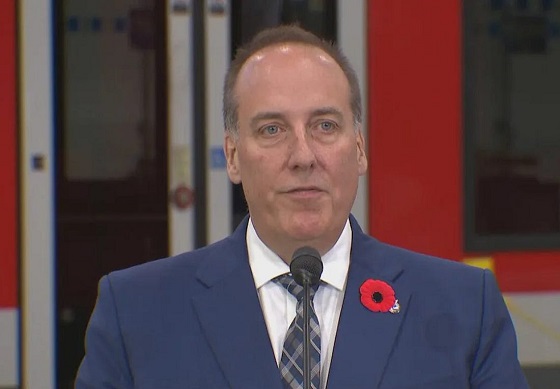International
Shocking images appear to show FBI agent with gun drawn raiding bedroom of J6 protester’s baby

From LifeSiteNews
X user John Strand posted what appear to be still-frame photographs taken from body camera footage during a raid on the home of a January 6 prisoner showing an FBI agent storming an infant’s bedroom.
Shocking images that appear to show FBI agents storming an infant’s bedroom with their guns drawn went viral on social media today.
X user John Strand posted what looks to be still-frame photographs taken from body camera footage of an FBI agent during a raid on the home of January 6 prisoner on an unspecified date at least two years ago.
“Shocking photos of a violent FBI raid executed against a peaceful J6er, terrorizing his young children,” Strand said. “The insane part? He had already surrendered to agents—but they assaulted his family at home anyway! THIS is the evil being purged from the FBI—and Democrats defend it?”
According to the Washington Times, Strand was sentenced to two years and eight moths in prison after being found guilty of a felony and four misdemeanors related to his actions in Washington, D.C., on January 6, 2021. He was released last July after serving a year behind bars in a Louisiana prison. A former model and actor, he is currently the creative director at America’s Frontline Doctors.
Strand has been posting shocking images to his X account for over a year detailing the FBI’s raid on Bobby DeGregoris’ home. DeGregoris was also found guilty of felony and misdemeanor chargers for January 6 activities, per the U.S. District Attorney’s Office website.
In a post published in December 2024, Strand shared a video of the raid while stating, “these fascist government stormtroopers drag his wife and kids into subzero conditions, terrorizing them with assault rifles.”
DeGregoris, who apparently is now free, responded to an X user who reshared Strand’s post.
“This was their Superbowl,” he said to someone who accused the agents of being “excited about the opportunity to put on all their gear and go play cops and robbers.”
On the day he was sworn in, Donald Trump pardoned nearly all of the more than 1,500 January 6 defendants. The document signed by Trump proclaimed that “a grave national injustice … has been perpetrated upon the American people over the last four years.”
The order further demanded that individuals who were being held in prison be “released immediately” and that all pending indictments against potential January 6 defendants be dismissed.
Artificial Intelligence
AI Faces Energy Problem With Only One Solution, Oil and Gas


From the Daily Caller News Foundation
Which came first, the chicken or the egg? It’s one of the grand conundrums of history, and it is one that is impacting the rapidly expanding AI datacenter industry related to feeding its voracious electricity needs.
Which comes first, the datacenters or the electricity required to make them go? Without the power, nothing works. It must exist first, or the datacenter won’t go. Without the datacenter, the AI tech doesn’t go, either.
Logic would dictate that datacenter developers who plan to source their power needs with proprietary generation would build it first, before the datacenter is completed. But logic is never simple when billions in capital investment is at risk, along with the need to generate profits as quickly as possible.
Dear Readers:
As a nonprofit, we are dependent on the generosity of our readers.
Please consider making a small donation of any amount here.
Thank you!
Building a power plant is a multi-year project, which itself involves heavy capital investment, and few developers have years to wait. The competition with China to win the race to become the global standard setters in the AI realm is happening now, not in 2027, when a new natural gas plant might be ready to go, or in 2035, the soonest you can reasonably hope to have a new nuclear plant in operation.
Some developers still virtue signal about wind and solar, but the industry’s 99.999% uptime requirement renders them impractical for this role. Besides, with the IRA subsidies on their way out, the economics no longer work.
So, if the datacenter is the chicken in this analogy and the electricity is the egg, real-world considerations dictate that, in most cases, the chicken must come first. That currently leaves many datacenter developers little choice but to force their big demand loads onto the local grid, often straining available capacity and causing utility rates to rise for all customers in the process.
This reality created a ready-made political issue that was exploited by Democrats in the recent Virginia and New Jersey elections, as they laid all the blame on their party’s favorite bogeyman, President Donald Trump. Never mind that this dynamic began long before Jan. 20, when Joe Biden’s autopen was still in charge: This isn’t about the pesky details, but about politics.
In New Jersey, Democrat winner Mikie Sherrill exploited the demonization tactic, telling voters she plans to declare a state of emergency on utility costs and freeze consumers’ utility rates upon being sworn into office. What happens after that wasn’t specified, but it made a good siren song to voters struggling to pay their utility bills each month while still making ends meet.
In her Virginia campaign, Democrat gubernatorial winner Abigail Spanberger attracted votes with a promise to force datacenter developers to “pay their own way and their fair share” of the rising costs of electricity in her state. How she would make that happen is anyone’s guess and really didn’t matter: It was the tactic that counted, and big tech makes for almost as good a bogeyman as Trump or oil companies.
For the Big Tech developers, this is one of the reputational prices they must pay for putting the chicken before the egg. On the positive side, though, this reality is creating big opportunity in other states like Texas. There, big oil companies Chevron and ExxonMobil are both in talks with hyperscalers to help meet their electricity needs.
Chevron has plans to build a massive power generation facility that would exploit its own Permian Basin natural gas production to provide as much as 2.5 gigawatts of power to regional datacenters. CEO Mike Wirth says his team expects to make a final investment decision early next year with a target to have the first plant up and running by the end of 2027.
ExxonMobil CEO Darren Woods recently detailed his company’s plans to leverage its expertise in the realm of carbon capture and storage to help developers lower their emissions profiles when sourcing their needs via natural gas generation.
“We secured locations. We’ve got the existing infrastructure, certainly have the know-how in terms of the technology of capturing, transporting and storing [carbon dioxide],” Woods told investors.
It’s an opportunity-rich environment in which companies must strive to find ways to put the eggs before the chickens before ambitious politicians insert themselves into the process. As the recent elections showed, the time remaining to get that done is growing short.
David Blackmon is an energy writer and consultant based in Texas. He spent 40 years in the oil and gas business, where he specialized in public policy and communications.
Dr John Campbell
Cures for Cancer? A new study shows incredible results from cheap generic drug Fenbendazole

From Dr. John Campbell
You won’t hear much about Fenbendazole from the regular pipeline of medical information. There could be many reasons for that. For one, it’s primarily known for it’s use in veterinary medicine. Somehow during COVID the medical information pipeline convinced millions that if a drug is used on horses or other animals it couldn’t work for humans. Not sure how they got away with that one considering the use of animal trials for much of modern medical history.
Another possible reason, one that makes at least as much sense, is that there’s no business case for Fenbendazole. It’s been around for decades and its patent expired in the early 1990’s. That means it’s considered a generic drug that a pharmaceutical company from India could (and does) produce in mass quantities for very little profit (compared to non-generics).
So Fenbendazole is an inexpensive, widely accessible antiparasitic drug used in veterinary medicine. During the COVID pandemic a number of doctors, desperate for a suitable treatment, tried it with reportedly great levels of success. Over some time they discovered it might be useful elsewhere. Some doctors are using Fenbendazole to help treat late stage cancer. Often this is prescribed when the regular treatments clearly aren’t working and cancer is approaching or has already been declared stage 4.
What they’ve found at least in some cases is astounding results. This has resulted in a new study which medical researcher Dr. John Campbell shares in this video.
-

 Alberta2 days ago
Alberta2 days agoFederal budget: It’s not easy being green
-

 Health21 hours ago
Health21 hours agoLack of adequate health care pushing Canadians toward assisted suicide
-

 National13 hours ago
National13 hours agoWatchdog Demands Answers as MP Chris d’Entremont Crosses Floor
-

 Alberta13 hours ago
Alberta13 hours agoATA Collect $72 Million in Dues But Couldn’t Pay Striking Teachers a Dime
-

 Business2 days ago
Business2 days agoWill Paramount turn the tide of legacy media and entertainment?
-

 Artificial Intelligence12 hours ago
Artificial Intelligence12 hours agoAI seems fairly impressed by Pierre Poilievre’s ability to communicate
-

 Energy2 days ago
Energy2 days agoA picture is worth a thousand spreadsheets
-

 Energy2 days ago
Energy2 days agoIt should not take a crisis for Canada to develop the resources that make people and communities thrive.









